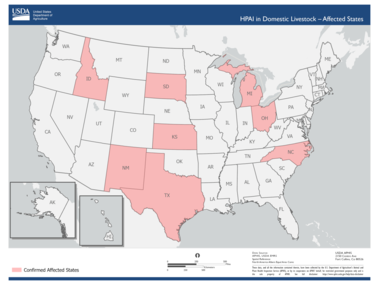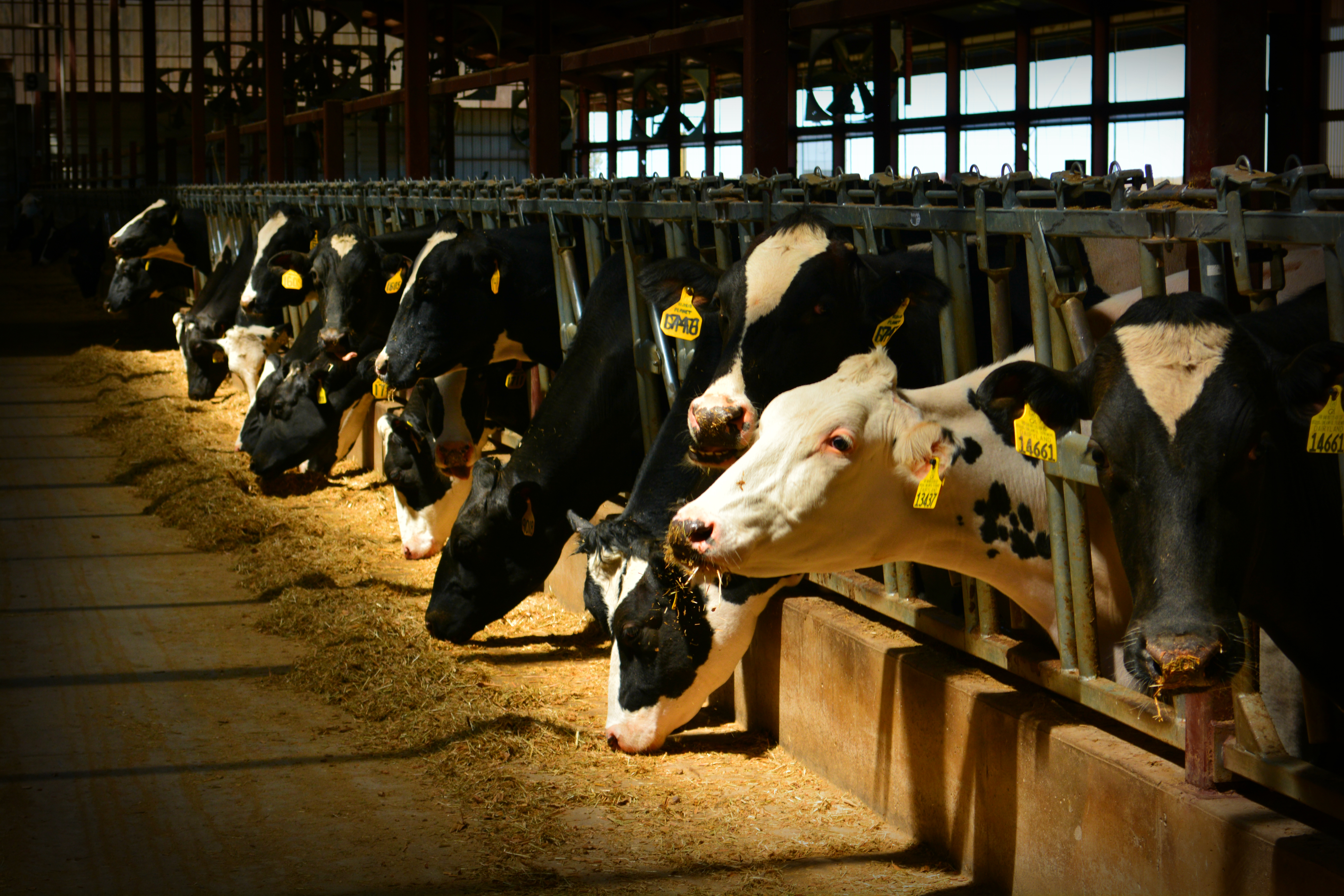DAIRY CATTLE INFORMATION
H5N1 Influenza in dairy cattle is an emerging disease. Any new information pertinent to Nebraska dairy producers will be posted as an update to the Nebraska Dairy Extension website.
Biosecurity risk assessment for dairy farms
Nebraska dairy producers and veterinarians can use the risk assessment document (link below) to create or enhance biosecurity practices. The focus of the principles outlined here is on preventing the introduction and/or spread of H5N1 highly pathogenic avian influenza in dairy cattle, but many of the principles apply to all infectious diseases that cattle are susceptible to.
Dairy Cattle H5N1 Influenza Update
By Matt Hille, DVM, PhD
Veterinary Pathologist and Extension Specialist
April 17, 2024--The information provided below is intended to provide Nebraska dairy producers and farm workers with a brief overall summary of current information regarding the emerging H5N1 disease in dairy cattle in the United States. All information is current to the author’s knowledge at the time of writing.
Background and scope
- In late February and early March of 2024, some dairy cattle in the panhandle of Texas presented with a sudden drop in milk production. Individual cow production dropped 20% in some cases.
- On March 25th, the National Veterinary Services Laboratory (NVSL) in Ames, Iowa confirmed H5N1 in a milk sample of an affected cow.
- Wild birds are presumed to be the reservoir host for this specific clade (or strain) of virus.
- The virus has been confirmed on 28 premises across 8 states as of April 16. See map below obtained from USDA APHIS.

Clinical signs
Affected cows have reportedly been presenting with all or a combination of the following clinical signs:
- Sudden drop in milk production with some reports of 20% or more reduction in milk
- Thickened milk (colustrum-like consistency)
- Changes in feces consistency with most reporting dry/tacky feces and a smaller number of cases reporting diarrhea
- Decreased feed intake
- Lethargy
- Fever
The virus appears to mainly be affecting older lactating dairy cows.
The number of cows affected on a given farm is often 10-15%.
Very little to no mortality observed among affected cows.
In affected cows that are not culled, there are reports of clinical recovery 1-2 weeks after the initial clinical signs. Despite clinical recovery, these cows do not seem to return to normal milk production levels.
Diagnostic testing
- No confirmed cases have been diagnosed in the state of Nebraska as of April 17, 2024.
- Testing can be performed by a National Animal Health Laboratory Network (NAHLN) diagnostic laboratory.
- In Nebraska, the Nebraska Veterinary Diagnostic Center is an NAHLN lab and is prepared to test samples if necessary.
- Approval from the Nebraska Department of Agriculture (NDA) is required before testing can be performed.
- The NDA website on HPAI in livestock can be found here.
Animal movement
- As of April 1, the NDA is requiring permit approval for the importation of any female dairy cattle into the state of Nebraska (see NDA website for more information on import permits).
- It is advisable to avoid animal movement unless crucial to business operations.
- If animal movement is deemed necessary, consult with your herd veterinarian and/or the NDA to assure all requirements are being met.
- Restrictions on animal movement to and from Nebraska and other states may change on short notice depending upon any new cases diagnosed. It is crucial to always obtain up-to-date information regarding movement requirements before moving cattle.
- It is important to be aware that even cattle showing no clinical signs of disease can be harboring virus and serve as a source of infection for other cattle.
Human health
- There has been a single confirmed case of H5N1 in a dairy worker in Texas. The worker presented with conjunctivitis (inflammation of the tissues around the eye) and was treated.
- The risk to human health is currently regarded as low as it pertains to H5N1 infecting humans from dairy cattle according to the CDC. However, given the confirmed diagnosis in the dairy worker in Texas, and confirmed human infections with Avian Influenza A viruses from previous outbreaks, the risk to human health is not zero.
- Therefore, it is prudent to follow practical steps to prevent human infections by using appropriate personal protective equipment (PPE), particularly in areas where raw milk is handled.
- Examples of appropriate PPE for H5N1 would include:
- Facemasks
- Eye protection
- Disposable rubber gloves
- Disposable (or at least clean) coveralls
- Disposable boot covers
- It is important to provide PPE that fits appropriately and to make sure workers understand proper fit and usage.
- Some PPE recommendations being made by health officials may not be practical for every dairy farm, such as disposable coveralls during the summer months. Producers should make a realistic assessment of their operation and the likelihood that workers will adhere to a PPE policy. Incorporating at least some PPE protection for workers (that they will actually use) is beneficial compared to nothing at all.
Other important things to consider regarding preventing human infections include:
- Avoid eating and drinking in areas where the food or drink can be contaminated with raw milk.
- Note hand wash stations on the farm, and practice routine hand washing.
- Avoid drinking raw milk or consuming products made with raw milk. As mentioned, animals can carry virus whether they appear sick or not.
- Avoid touching your face/eyes with hands.
- Your local health department can serve as the resource for any potential questions regarding human testing. The map of DHHS contacts in Nebraska can be found here.
Farm biosecurity
- There is evidence to suggest lateral (cow-to-cow) transmission of the virus in dairy cattle. Precautions regarding importing any new cattle to a farm should be considered.
- Isolating any new cattle for two weeks after arrival before incorporating into the home herd will help minimize the likelihood of disease introduction.
- The highest viral load appears to be present in milk. Therefore, anything that comes in contact with untreated milk has the potential to serve as a mechanical vector for the virus. Examples of potential mechanical vectors include:
- Non-bovine animals (domestic and wildlife) on the farm
- Vehicles
- Footwear and other clothing
- Machinery
- It is important to think about food or supply delivery locations from vehicles that have recently visited other farms. Having a dedicated unloading area away from cows would help minimize the chances of virus introduction via off-farm vehicle traffic.
- Follow strict milking practices such as equipment disinfection.
- See the National Mastitis Council Recommended Milking Procedures for more information.
- Closely monitor cows for the clinical signs mentioned above, particularly an unexplained sudden drop in milk production.
- Farm biosecurity is often site specific. While there are general principles all farms can follow, these principles need to be applied in context with the particular farm in question. Your regular herd veterinarian can serve as a great resource regarding implementing or enhancing biosecurity measures as they are familiar with your particular operation.
- A FARM Biosecurity-Enhanced short course is available via the National Milk Producers Federation that may be beneficial for producers and any on-farm dairy workers. Email dairyfarm@nmpf.org to request access to the training material. The time to complete the course is approximately 45 minutes.
Additional resources and contacts
- NMPF National Milk Producers Federation
- Nebraska State Dairy Association (NSDA)
- Nebraska Dairy Extension
- Highly Pathogenic Avian Influenza in Livestock (NDA)
- Highly Pathogenic Avian Influenza (HPAI) Detections in Livestock (USDA APHIS)
- Nebraska Veterinary Diagnostic Center
- Dr. Matt Hille - Extension Veterinarian: mhille@unl.edu
- Dr. Paul Kononoff - Dairy Extension Specialist: pkononoff2@unl.edu
Additional Resources
National Milk Producers Federation
Nebraska Department of Agriculture (NDA)
Nebraska State Dairy Association (NSDA)
Nebraska Veterinary Diagnostic Center (NVDC)
Contacts
Dr. Matt Hille, Extension Veterinarian: mhille@unl.edu
Dr. Paul Kononoff, Dairy Extension Specialist: pkononoff2@unl.edu
